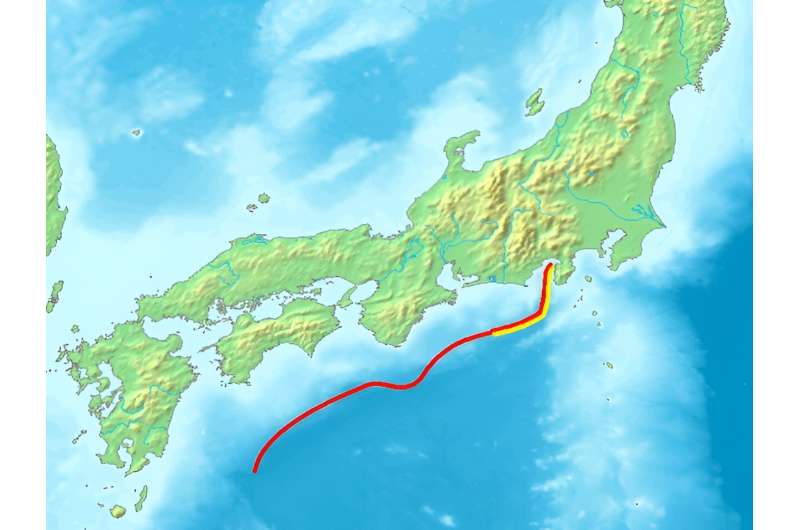This article has been reviewed according to Science X's editorial process and policies. Editors have highlighted the following attributes while ensuring the content's credibility:
fact-checked
trusted source
proofread
A mathematical model for studying methane hydrate distribution in the Nankai Trough

Methane hydrate is a naturally occurring ice-like crystalline solid that forms when methane and water are subjected to geological high-pressure and low-temperature conditions. It is often found trapped in continental margin sediments and permafrost.
Owing to its immense potential as a possible energy resource, researchers have attempted to get a better understanding of the geochemical and geophysical factors that control the distribution of methane hydrate reservoirs.
However, these deposits take thousands of years to form, and their reservoirs are often found in geologically heterogeneous conditions. This makes it difficult to conduct a real-time or thorough evaluation of the formation, distribution, or accumulation of methane hydrates.
In a study published in Island Arc, Associate Professor Hitoshi Tomaru, along with Chao Xu from the Graduate School of Science and Engineering, Chiba University, have now developed a mathematical model to circumvent this problem. They investigated the distribution characteristics and accumulation mechanisms of methane hydrates in the Nankai Trough of Japan indirectly with the help of numerical simulations using a one-dimensional flow model.
The researchers carried out numerical simulations of the hydrate generation process by modifying the mathematical model proposed by Liu and Fleming in 2007 to investigate methane hydrate saturation (Sh). They used logging and geochemical data from the Kumano Forearc Basin of the Nankai Trough, which is located off the shore of the main island of Japan and is home to considerable hydrate reserves.
"With this model, we aimed to obtain insights into the distribution regularity of methane hydrate and the factors controlling hydrate generation. So, building on the original model, we explored the effects of deep fluid supply and reservoir lithology on the distribution and quantity of methane hydrates. We employed a smoother flux configuration to better observe the impact of methane flux variation on the simulation results," explains Dr. Tomaru.
Considering the importance of methane flux and water flow for the formation and distribution of methane hydrates, the researchers investigated three distinct scenarios corresponding to low-, moderate-, and high-methane flux. They observed that the hydrate distribution in the Nankai Trough area coincided with the results when the methane flux was relatively small.
Prior studies have shown that in low-methane flux environments, Sh is highest near the base of the gas hydrate stability zone. In contrast, the formation of hydrates is significantly faster, and Sh is highest at the sea floor in high-methane flux regions. In other words, low-methane flux reduces Sh upward from the bottom, and high-methane flux increases it downward. The simulation results obtained in this study add to these observations and suggest that geological factors such as the distribution of fractures and a deep fissure in a rock formation also influence the sediment stress conditions and constrain the flow regime.
Furthermore, the team used typical permeability values of sand and mud to run simulations and understand the impact of permeability changes caused by lithological units on hydrate distribution. The results further revealed that Sh substantially increased in the sand layer but drastically decreased in the mud layer.
Elaborating on these results, Dr. Tomaru says, "Our simulation model provides valuable insights into the location, saturation, and distribution of natural methane hydrate resources in deep-sea sediments without the need for energy- and labor-intensive processes like physical drilling or coring of the sea floor."
Moving forward, these findings could enable the development of more efficient strategies for methane hydrate generation and contribute to the development of better geohazard prevention plans.
More information: Chao Xu et al, Simulation of methane hydrate formation in coarse‐ to fine‐grained sediments in the Nankai Trough, Japan, Island Arc (2023). DOI: 10.1111/iar.12502
Provided by Chiba University




















